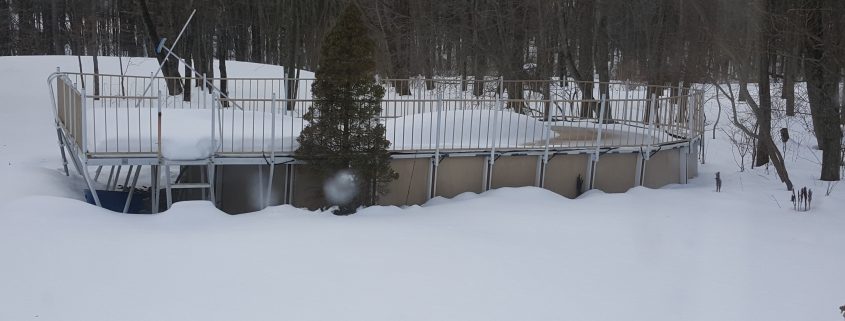HOW TO AVOID SWIMMING POOL and SPA DAMAGE IN THE COLDER MONTHS
The months between freezing winter and the thaw of spring are the perfect time for damage to occur to your clients’ swimming pools and spas.
Homeowners can become complacent with their pool maintenance, allowing problems to not only begin, but to remain unaddressed until they want to use their pools later in the year.
Encouraging your clients to keep up pool maintenance will help reduce damage from occurring, thereby reducing claims that are made for pool repairs. Here are some gentle reminders to pass on to your clients, so they can take care of their pools from now until spring.
Check Pool Covers Throughout Winter Months
During the winter months, pool covers can be damaged when snow, rain, or debris are allowed to remain or pile up on the cover. The heavy weight of snow can cause a cover to break, and most pool covers are not designed to hold an extreme amount of weight. Pool covers should be kept clear of snow and debris, and should be checked after rain to ensure that the cover is properly in place. In addition, keeping the pool cover clear will help ensure that rainwater, debris, and melted snow do not fall into the pool water when the pool is opened in the spring. Rain water and melted snow can upset the chemical balance in the pool water, which can cause staining and damage to a swimming pool liner.
To find out other tips please click here.
Check Water Level Throughout Winter
When pools are closed for the winter, the water is lowered below the level of the skimmer. This way, if the water freezes, it won’t damage the tiles or skimmer when the frozen water expands. However, a faulty cover coupled with heavy rain or snow can cause the water level to rise. When that water freezes, it can cause extensive damage to pools. Likewise, if a leak is present and the water level drops significantly, it can cause serious damage to the pool cover and pool. Pool covers generally sit on top of the water, and if that water drops down, the weight of the cover can cause the cover to break, or to rip away portions of the pool liner. Where possible, homeowners should check the water level of their pool throughout the winter to make sure that it has remained at the appropriate level.
Maintain Landscaping Around Pool
If trees and shrubs around the pool area become overgrown, and windy weather strikes, branches and other plant life can puncture and damage the swimming pool cover, leading to an array of other issues. Keeping landscaping in check is an important defensive maneuver when it comes to keeping the pool in good condition.
Check the Pool as Weather Warms
When the weather starts to warm up, frozen water will start to thaw. Huge chunks of ice can detach and damage pool liners and covers. It is essential for homeowners to keep an eye on the pool as the weather warms up. If the weather remains mild throughout the winter, homeowners should check the chemical balance throughout the winter, since warmer weather encourages algae growth.
Preparing for Warm Weather
During the winter when pools aren’t being used is an ideal time for homeowners to clean out their old and expired pool supplies, replace faulty equipment, and generally prepare for the warm weather. Old chemicals should be properly disposed of and replaced with fresh product. Broken equipment should be replaced so that everything is ready to go when the pool is opened for the spring.
By encouraging homeowners to care for their pool throughout the winter, the chance for damage to occur is mitigated, not only making pool owning easier for homeowners, but also reducing claims for insurance professionals.




Leave a Reply
Want to join the discussion?Feel free to contribute!